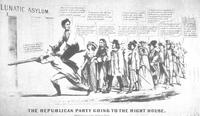1860
| Candidate |
Popular
|
Electoral
|
| Abraham Lincoln Republican |
1,865,908
|
180
|
| John C. Breckinridge Southern Democrat |
848,019
|
72
|
| John Bell Constitutional Union |
590,901
|
39
|
| Stephen A. Douglas Democrat |
1,380,202
|
12
|
Abraham Lincoln, 1863 (public domain) from the Mathew Brady studio |
Four candidates were nominated in 1860, an election in which sectionalism carried the day. Here we see all four candidates involved in the "national sport." (19A-1066556) John Bell, the Constitutional or National Union candidate, pledged to uphold the Constitution and Union; Stephen Douglas, the Democratic candidate pledged to popular sovereignty; John C. Breckinridge, the "Dixiecrat" candidate, was in favor of protection of slave territory; and Abraham Lincoln, the Republican candidate, had a platform to unite the country (19B-1066557). All four candidates were plainly involved in sectional campaigns, however (19C-1066558). The Douglas-Breckinridge split over slavery, harmful to the Democratic Party, is here caricatured (19D-1066959).
As seen in the following series, Lincoln's reputation as the "rail-splitter" was seized upon by cartoonists (19E-1066960, 19F-1066961, 19G-1066962). Many cartoons similar to these were published.
Although the Republican Party was more firmly established, it was still depicted as a motley group of dissidents (19H-1066963). This crowd looks much like the one surrounding Fremont in a cartoon from 1856 (see 18G-1066555).
Fears of secession were beginning to surface in the nation at this time, and some saw Lincoln's election, totally unacceptable to the South, as just the wedge to drive the union apart (19I-1066964). But the "rail-splitter" was elected.











